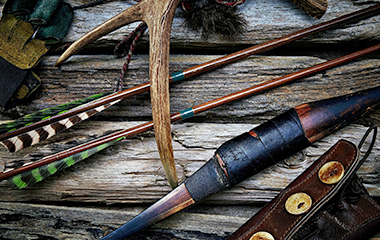Bows and Bowstrings: Then and Now
The Evolution of Modern Bows and Bowstrings
 The basic bow and arrow is a very old weapon system that was used widely for hunting and warfare in many cultures throughout the world since prehistoric times. Arrowheads found at archaeological sites in northern Europe suggest that bows have been used to shoot arrows since the late Paleolithic period. Since then, the bow and arrow weapon system has undergone numerous advancements, innovations, and improvements to its design and construction to evolve into a highly-effective weapon. In the heyday of the bow and arrow as a weapon of war, archers were some of the most feared warriors on ancient and medieval battlefields.
The basic bow and arrow is a very old weapon system that was used widely for hunting and warfare in many cultures throughout the world since prehistoric times. Arrowheads found at archaeological sites in northern Europe suggest that bows have been used to shoot arrows since the late Paleolithic period. Since then, the bow and arrow weapon system has undergone numerous advancements, innovations, and improvements to its design and construction to evolve into a highly-effective weapon. In the heyday of the bow and arrow as a weapon of war, archers were some of the most feared warriors on ancient and medieval battlefields.
While firearms may have replaced bows and arrows on the battlefield, bow and arrow manufacture is still alive and well thanks to the popularity of bowhunting and recreational archery. Modern bows and bowstrings are the result of thousands of years of innovation and technological advancement and are capable of sending arrows with deadly accuracy at ranges of over 40 yards.
Here is a brief look at how the construction of bows and bowstrings has progressed since their most primitive forms to the weapons used by recreational archers and bowhunters today.
Bows
Not surprisingly, bow construction has changed a lot over the 64,000 years since they started being made. Up until the development of light, high-strength materials such as fiberglass and carbon, bows were made from pliant wood. The earliest bows were simple staffs of pliant wood strung with animal guts. Later improvements included the use of animal sinew material to strengthen the bow and curving its limbs for increased draw power. Today’s bows are constructed out of materials including carbon fiber, metal alloys, carbon fiber, and composite materials.
Most bows found today fall into one of four main types:
- Compound bows: These modern bows feature cams, pulleys, and cables to assist the archer in holding a heavy draw weight. The materials used to make modern compounds make them more resistant to water and temperature changes than traditional bows.
- Recurve bows: The distinctive curves of these bows allow them to store more energy to shoot arrows at greater speeds arrows requiring less strength on the part of the archer.
- Traditional Longbows: The oldest and simplest type of bow around, the longbow consists of a long, slightly-arched piece of wood. Because it has no sights or arrow rests, the longbow is much harder to aim than other, more modern bows and cannot shoot arrows at the same velocity.
- Crossbows: An entirely different bow configuration, the crossbow consists of a much smaller bow mounted horizontally on top of a stock in a configuration that resembles a gun. They shoot shorter projectiles, called bolts.
Bowstrings
Just as crucial in the bow-and-arrow weapon system as the bow itself are the bowstrings used to launch the arrows into flight. Much like with bow construction, the materials used to make bowstrings can significantly affect the durability and performance of the bowstring. Since the first bows were strung using animal tissue and plant, bowstrings too have undone significant improvement in their construction. Modern bowstrings are constructed out of twisted threads of synthetic materials that offer more more strength and durability than their natural predecessors.
LEARN MORE
